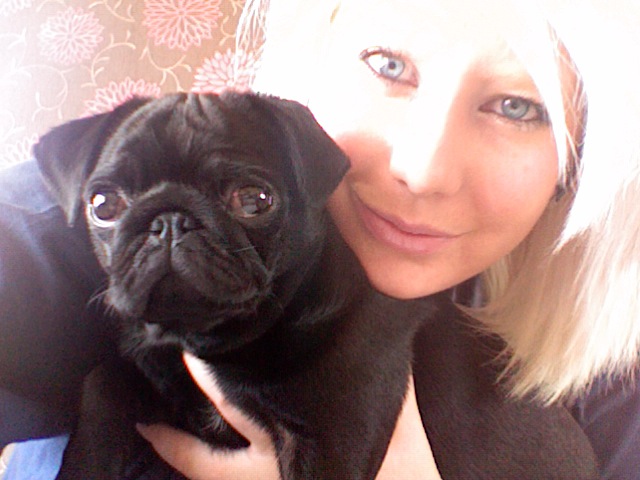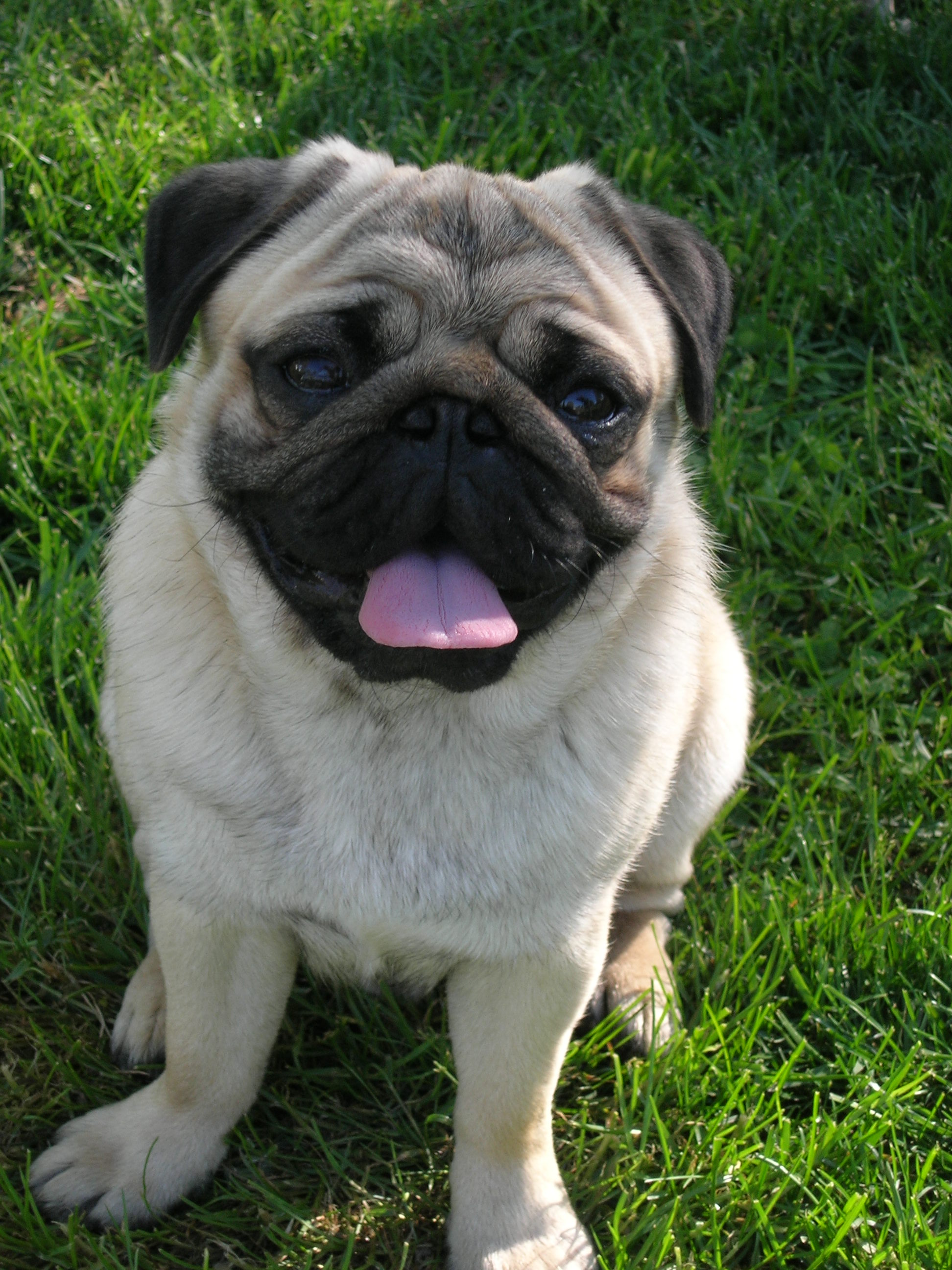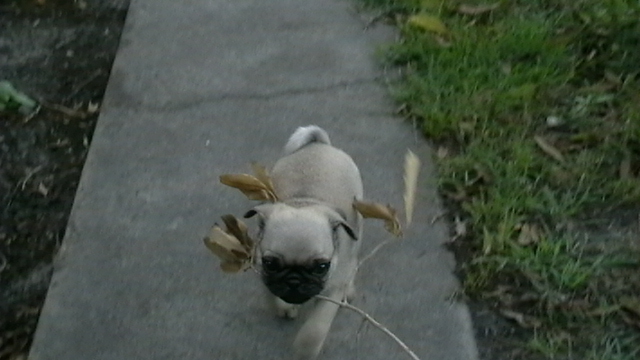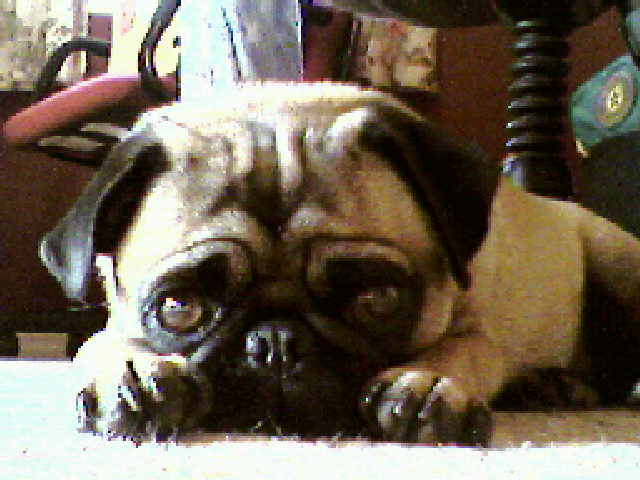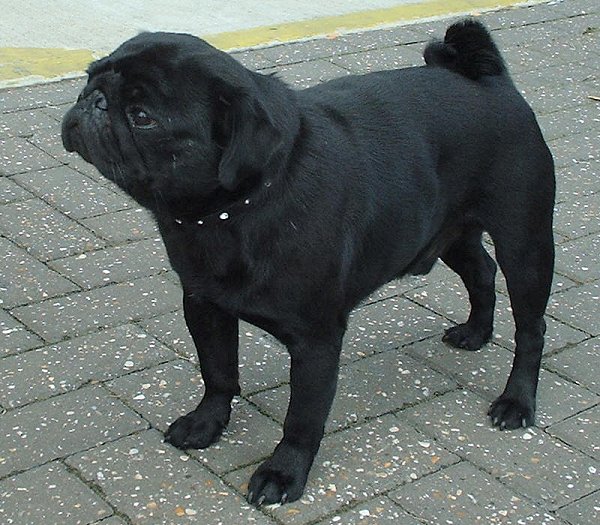
(Carlin) (Mops) The Pug is a cute and commonly seen breed. The breed’s head is covered in wrinkles like a small version of a Shar Pei or Bulldog. Pugs have an extremely short muzzle which looks scrunched up and ends with a small black nose. Their cute faces and large, round eyes are often full of expressions. Small folded ears finish off their adorable, unique face. Despite their small size, the Pug has a broad neck with a dewlap that leads to a wide, square body. Pugs have short skinny legs and a curled tail that lies on its back. Short fur covers their entire small body. The most common fur colors are fawn and black, but they can also be silver or apricot.
User added infoPugs are mainly recognized by their tightly-curled tail, black wrinkly face and fawn/tan fur and small build.
add infoAlways sweet and cheerful is how the Pug is often described. Family is most important to these little dogs that thrive on attention. A gentle nature makes the Pug great for playing with children. Strangers and dogs will receive the same playful and loving attention a family member would. Plus, owners do not need to worry about Pugs around small animals. Intelligence makes them highly trainable but also independent and stubborn. Sensitivity to punishment makes it important to not yell at Pugs or to use a harsh voice when correcting the breed.
Pugs are natural clowns and are good with small children.
add infoThe Pug has some health problems mostly because of how they were bred. These problems include extreme breathing problems caused by their short muzzle and ulcers on the cornea and inflammation of the cornea caused by their eyes bulging. Other health problems are just genetic, including allergies. Also common are colds, eye weeping, and skin problems. Many Pugs find it hard to give birth naturally and need Cesarean Sections. Another important thing for owners to remember is that Pugs will easily over eat and become obese. Life expectancy for a Pug is between 12 to15 years.
On average, a Pug will live 12 to 15 years. Be aware of breathing problems. The flat, wrinkly face makes it hard for a Pug to breathe sometimes. Be sure not to overwork this breed if it has breathing problems.
add infoPugs probably developed in Asia around the 5th century BC. However, there are numerous alternative theories. What is assumed is that the breed ended up in England after British forces found the dogs in China during an attack. The breed was popular among artists, as a companion in monasteries, and as fashion accessories during the Victorian Era. When pugs finally arrived in Europe before the 16th century, they quickly became adopted as a favorite pet of the wealthy. In 1885, the Pug was finally recognized by the AKC.
The average life expectancy for this breed is 15 years
add infoGrooming is simple and not time consuming for this little breed. Regular baths and brushing sessions are needed and the wrinkles on their face should be cleaned every day. Pugs are active and enjoy playing games and walking. However, they do get tired quickly and may start wheezing which means they are overexerted. This breed still should be exercised because they can become obese easily. Special care should be taken to prevent this breed from getting too cold or hot because they cannot withstand harsh climates. Pugs are more than moderate shedders year round, with a heavier shedding in the spring when living in four season climates. Bladed combs are best for controlling short top and undercoats.
They are moderate shedders year round even with proper grooming. It's best to clean the wrinkles on their face every other day to avoid infection.
Pugs have a coat that sheds heavily. The hairs are like small needles and find their way into clothes and carpets.
add infoThe Pug is a perky dog that gets along with all people and animals. Apartment living is fine for this breed because they are calm indoors and do not need a yard. Care should be taken before purchasing a Pug because of their numerous health concerns. A loving family with time to play and provide love is the Pug’s ideal home. However, Pugs cannot be in extreme hot or cold climates.
Pugs love to be with their owners and hate to be alone. They enjoy companionship with dogs. Most prefer sweaters when it's cold outside as they don't handle harsh weather that well. They can also be trained to eliminate on pads if the weather is too harsh.
add info| Puppies For Sale | Find a Breeder | Rescue a Dog |
|---|---|---|
| Be the First to take out an Ad! |

Berlin, DE
Die Hobbyzucht im „Butzemannhaus“ ist geprägt von Liebe und Respekt gegenüber den Tieren. Ich sehe meine Tiere nicht... |
Be the First to take out an Ad! |
 |
He probably isn't getting enough exercise. He is chewing and tearing things up because he is frustrated. Chewing and tearing things up is a way to vent that energy. A couple of 20-30 minute leash walks plus some playtime in the yard/dog park should help him relax. |
 |
I only have one pug. I aso have a Boston Bull and our pug will do the same thing! She tease-takes thing away from the Bull dog! She is a lot younger and thinks she can get away with it too ! What do you do about it?? |
 |
A bark collar! Yes, perfect tool for bark training. Or a spray collar. Whenever the dog barks, a bitter apple spray will spray right in the dog's face. |
 |
Puppies should NEVER leave their mother before 8 weeks of age. Preferably 9, but NEVER before 8. You should look for another breeder. A good, reputable breeder would not be trying to whisk puppies away from their mother at such an age. |
 |
This is totally false. The pug is one breed, black or fawn, a pug is a pug. Both double coats, therefore, both shed just as much. There are alot of pug rumours in the world and I would like you not to believe half of them. Shedding can be taken care of with a regular brushing once a week. Watch out for health problems and ticks and fleas, and grooming should be an enjoyable experience for both the owner and the dog. I know someone who owns a pug, and she is the healthiest dog in the neighbourhood. Sheds just as much as a fawn pug, and just as friendly. Remember, no matter the colour, it's the same breed, the PUG! |
 |
I would rather do it separately so that the pugs don't get distracted by each other. |
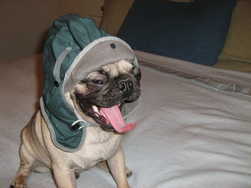 |
You would become old till you finish reading this, but if you want to get a new and good kind of pug you should be patient and understand what I am telling you. Read the following carefully: Pugs are decidedly square and cobby with compact, stout bodies having well decided proportions and a developed muscle structure. The Pug's muzzle should be short, blunt and square. Their bodies should be short and cobby with a wide chest. Their legs strong, straight and of moderate length. Lean and leggy Pugs, as well as those with short legs and long bodies, are not good examples of the breed, but they still make wonderful family pets. The head should be large, round and massive with profuse wrinkles. The eyes, another of the Pug's predominant features, should be dark in color, large, spherical in shape, and bold. Their expressions should be one that projects concern, attentiveness and eagerness. One look into the eyes of a Pug and you will fall in love with them immediately. The mask should be as black as possible, the darker and more defined the better. The ears are small and thin with a soft feeling, almost as if touching black velvet. Two shapes can be found in the ears, the "rose" and "button." The "button" shape, where the ear is folded over, is the preferred shape. The tail should be as tightly curled as possible and up, over the hip. A double curl is highly sought after and considered perfect. A Pug's coat should be a fine, soft, and short hair. It should be smooth and glossy and can be either silver, apricot-fawn or black. For silver and apricot-fawn colors the dog's mask, muzzle, ears and trace (the line extending along the dog's back from head to tail) should be as black as possible to form as complete a contrast as possible with the dog's coat color. |
 |
I have a 13 yr old male Pug. I have never been able to solve this. The best reason I got from a well informed vet is a maturity issue. The eat their mothers when they are young for the protein and some dogs just do not grow out of it. I have tired pills, water gun, training and punishment. The best thing to do is to keep it cleaned up as best as possible and watche them in the yard. Please do not get to upset and punish harshley. Pugs are sensitive. To a previous posting; firm is better than yelling. Dinovite also did not work, but it is good for nutrition. |
 |
I am a pug breeder and love all the color variations of pugs. So I have done a lot of research on the subject. To answer your question, true silver in the pug is a rare color indeed, which should not be confused with what is being called silver fawn (a white or nearly white pug with regular black markings and no black hairs over the body). I have only ever seen 1 true silver pug and have not found any pictures of one anywhere online currently. A few pictures of silvers I've seen are 100 yrs ago or more. So, it is not likely you have one, but not impossible either. As I said I did see 1 a couple of years ago, so they do exist. But most people wouldn't know one if they saw one. If one pops up in one of my litters, she'll be a keeper. |
 |
Sounds like you have a typical puppy on your hands. Try not to be so worried. You are not doing anything wrong. Pugs think they are people. So, like people, they have their own personality and preferences. I have adult dogs that take each piece of food somewhere else to eat it and then go back for another. I have one that tries to stash it and go back later to eat it. I have one that plays in his water dish and everytime he drinks will jump on my lap dripping water. You can train and teach, but they are still individuals, just like us. As far as dog foods. Please bear in mind that dogs are carnivores, so the FIRST ingredient should be meat. Corn is great for cows, but dogs weren't meant to eat large quantities of it. You can get lots of good info online about what really goes into commercial dog foods. Hope this helps and enjoy your puppy. |












